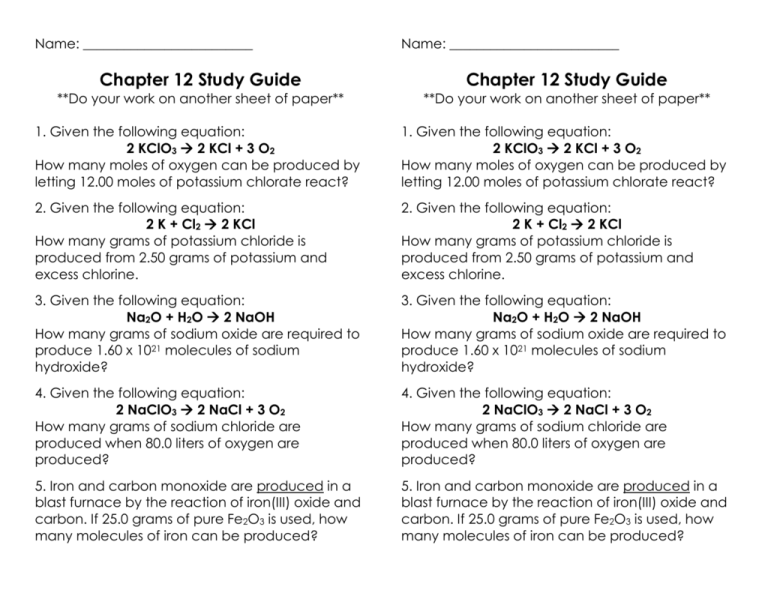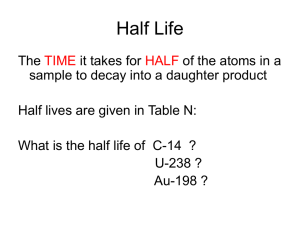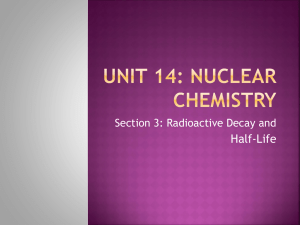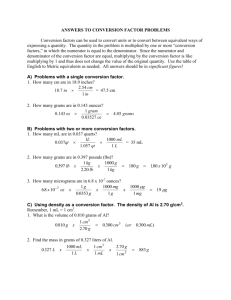Chapter 12 Study Guide
advertisement

Name: _________________________ Name: _________________________ Chapter 12 Study Guide Chapter 12 Study Guide **Do your work on another sheet of paper** **Do your work on another sheet of paper** 1. Given the following equation: 2 KClO3 2 KCl + 3 O2 How many moles of oxygen can be produced by letting 12.00 moles of potassium chlorate react? 1. Given the following equation: 2 KClO3 2 KCl + 3 O2 How many moles of oxygen can be produced by letting 12.00 moles of potassium chlorate react? 2. Given the following equation: 2 K + Cl2 2 KCl How many grams of potassium chloride is produced from 2.50 grams of potassium and excess chlorine. 2. Given the following equation: 2 K + Cl2 2 KCl How many grams of potassium chloride is produced from 2.50 grams of potassium and excess chlorine. 3. Given the following equation: Na2O + H2O 2 NaOH How many grams of sodium oxide are required to produce 1.60 x 1021 molecules of sodium hydroxide? 3. Given the following equation: Na2O + H2O 2 NaOH How many grams of sodium oxide are required to produce 1.60 x 1021 molecules of sodium hydroxide? 4. Given the following equation: 2 NaClO3 2 NaCl + 3 O2 How many grams of sodium chloride are produced when 80.0 liters of oxygen are produced? 4. Given the following equation: 2 NaClO3 2 NaCl + 3 O2 How many grams of sodium chloride are produced when 80.0 liters of oxygen are produced? 5. Iron and carbon monoxide are produced in a blast furnace by the reaction of iron(III) oxide and carbon. If 25.0 grams of pure Fe2O3 is used, how many molecules of iron can be produced? 5. Iron and carbon monoxide are produced in a blast furnace by the reaction of iron(III) oxide and carbon. If 25.0 grams of pure Fe2O3 is used, how many molecules of iron can be produced? 6. Glucose (C6H12O6) goes through combustion. If 120 grams of glucose are used, then how many liters of water are produced? 6. Glucose (C6H12O6) goes through combustion. If 120 grams of glucose are used, then how many liters of water are produced? 7. Given the following equation: Cu + 2 AgNO3 Cu(NO3)2 + 2 Ag If 72 grams of copper and 187 grams of silver (I) nitrate react, then how many grams of copper (II) nitrate will be produced? Identify the limiting and excess reagents. 7. Given the following equation: Cu + 2 AgNO3 Cu(NO3)2 + 2 Ag If 72 grams of copper and 187 grams of silver (I) nitrate react, then how many grams of copper (II) nitrate will be produced? Identify the limiting and excess reagents. 8. Given the following equation: 8 Fe + S8 8 FeS If 150 grams of iron react with 150 grams of sulfur, then how many grams of iron (II) sulfide are produced? 8. Given the following equation: 8 Fe + S8 8 FeS If 150 grams of iron react with 150 grams of sulfur, then how many grams of iron (II) sulfide are produced? 9. Given the following equation: Na2CO3 + 2 HNO3 2 NaNO3 + H2O + CO2 If 30 grams of sodium carbonate react to form 45.5 grams of sodium nitrate, then what is the percent yield? 9. Given the following equation: Na2CO3 + 2 HNO3 2 NaNO3 + H2O + CO2 If 30 grams of sodium carbonate react to form 45.5 grams of sodium nitrate, then what is the percent yield? 10. Given the following equation: 2Fe + 3O2 Fe2O3 If 100 grams of iron react with 90 grams of oxygen and 130 grams of iron(III)oxide is produced, then what is the percent yield? Identify the limiting and excess reagents. 10. Given the following equation: 2Fe + 3O2 Fe2O3 If 100 grams of iron react with 90 grams of oxygen and 130 grams of iron(III)oxide is produced, then what is the percent yield? Identify the limiting and excess reagents.








